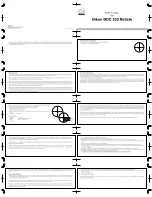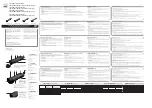
18
will likely appear star-like. Because planets are quite small in
apparent size, optional higher-power eyepieces are recom-
mended and often needed for detailed observations. Not all
the planets are generally visible at any one time.
JUPITER: The largest planet, Jupiter, is a great subject for
observation. You can see the disk of the giant planet and
watch the ever-changing positions of its four largest moons—
Io, Callisto, Europa, and Ganymede.
SATURN: The ringed planet is a breathtaking sight when it is
well positioned. The tilt angle of the rings varies over a period
of many years; sometimes they are seen edge-on, while at
other times they are broadside and look like giant “ears” on
each side of Saturn’s disk. A steady atmosphere (good see-
ing) is necessary for a good view. You will probably see a
bright “star” close by, which is Saturn’s brightest moon, Titan.
VENUS: At its brightest, Venus is the most luminous object in
the sky, excluding the Sun and the Moon. It is so bright that
sometimes it is visible to the naked eye during full daylight!
Ironically, Venus appears as a thin crescent, not a full disk,
when at its peak brightness. Because it is so close to the Sun,
it never wanders too far from the morning or evening horizon.
No surface markings can be seen on Venus, which is always
shrouded in dense clouds.
MARS: The Red Planet makes its closest approach to Earth
every two years. During close approaches you’ll see a red
disk, and may be able to see the polar ice cap.
D. The Stars
Stars will appear like twinkling points of light. Even powerful
telescopes cannot magnify stars to appear as more than a
point of light.You can, however, enjoy the different colors of the
stars and locate many pretty double and multiple stars. The
famous “Double-Double” in the constellation Lyra and the gor-
geous two-color double star Albireo in Cygnus are favorites.
Defocusing a star slightly can help bring out its color.
E. Deep-Sky Objects
Under dark skies, you can observe a wealth of fascinating
deep-sky objects, including gaseous nebulas, open and glob-
ular star clusters, and a variety of different types of galaxies.
Most deep-sky objects are very faint, so it is important that
you find an observing site well away from light pollution. Take
plenty of time to let your eyes adjust to the darkness. Do not
expect these subjects to appear like the photographs you see
in books and magazines; most will look like dim gray
smudges. Our eyes are not sensitive enough to see color in
deep-sky objects except in a few of the brightest ones. But as
you become more experienced and your observing skills get
sharper, you will be able to ferret out more and more subtle
details and structure.
To find deep sky objects in the sky, it is best to consult a star
chart and planisphere. These guides will help you locate the
brightest and best deep-sky objects for viewing with your
Observer 70.
6. Care and Maintenance
If you give your telescope reasonable care, it will last a life-
time. Store it in a clean, dry, dust free place, safe from rapid
changes in temperature and humidity. Do not store the tele-
scope outdoors, although storage in a garage or shed is OK.
Small components like eyepieces and other accessories
should be kept in a protective box or storage case. Keep the
caps on the front of the telescope and on the focuser draw-
tube when not in use.
Your Observer 70 telescope requires very little mechanical
maintenance. The optical tube is aluminum and has a smooth
painted finish that is fairly scratch resistant. If a scratch does
appear, it will not harm the telescope.
Cleaning Lenses
Any quality optical lens cleaning tissue and optical lens clean-
ing fluid specifically designed for multi-coated optics can be
used to clean the Observer 70’s objective lens (14) and the
exposed lenses of your eyepieces. Never use regular glass
cleaner or cleaning fluid designed for eyeglasses
Before cleaning with fluid and tissue, blow any loose particles
off the lens with a blower bulb or compressed air. Then apply
some cleaning fluid to a tissue, never directly on the optics.
Wipe the lens gently in a circular motion, then remove any
excess fluid with a fresh lens tissue. Oily fingerprints and
smudges may be removed using this method. Use caution—
rubbing too hard may scratch the lens. For the larger surface
of the objective lens, clean only a small area at a time, using
a fresh lens tissue on each area. Never reuse tissues.
7. Specifications
Optical tube: Aluminum
Objective lens diameter: 70mm
Objective lens: Achromatic, air-spaced, fully coated
Focal length: 700mm
Focal ratio: f/10.0
Focuser: Rack and pinion, accepts 1.25" eyepieces and
accessories
Eyepieces: 25mm and 10mm Explorer II eyepieces, fully
coated 1.25"
Magnification with supplied eyepieces: 28x (with 25mm) and
70x (with 10mm)
Tripod: Aluminum
Mount: EQ-1, German equatorial
Star diagonal: Mirror, 1.25"
Finder: EZ Finder II reflex sight
Motor drive: Optional
Weight: 10.5 lbs.
Содержание Observer 70 EQ 9882
Страница 2: ...2 ...
Страница 4: ...4 2 3 4 5 6 7 8 1 Observer 70 Refractor 9 11 12 10 13 Figure 1 Observer 70 EQ Components ...
Страница 19: ...19 ...































